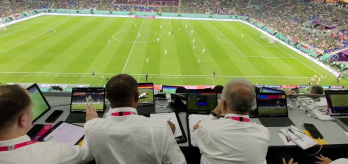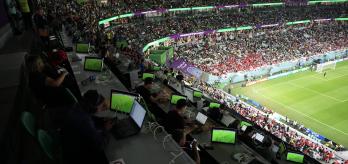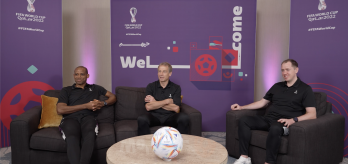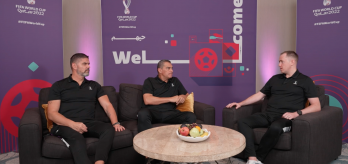At the halfway mark of FIFA World Cup Qatar 2022™, FIFA Group Leader Football Performance Analysis & Insights Chris Loxston sat down with Technical Experts Sunday Oliseh and Jürgen Klinsmann to analyse some of the major tactical trends of the tournament so far. In this episode of FIFA insight, the panel begin by discussing why teams are adopting more compact defensive units, and how the opposition can outmanoeuvre them. They then move on to investigate why teams are finding it more difficult to move the ball into the attacking third, and why players appear more reluctant than usual to engage defenders 1v1.
Watch video
Read summary
00:23
Compactness out of possession
In comparison to the World Cup in Russia four years ago, teams are tending to play in more compact defensive formations. The data shows that teams defending in high blocks are spread about 2m wider than they were in 2018, but the distance between the deepest and highest player is about around 1m shorter. In low blocks, teams are about 2m "shorter" than they were. Morocco's group stage match against Belgium provides a great example of how this compact block works in practice.
04:22
How to beat the block
There are various different ways of overcoming this defensive block. One way is to get the ball out wide, but the winger's first touch has to be forward, and they need support from their team-mates. A quick switch of play is another option, but the pass has to be very precise, and again, the winger who receives it has to be able to move the ball forward immediately. Above all, the attacking team has to be prepared to take risks – something Belgium failed to do in our example.
07:46
Reduction in final third entries
There have been fewer final third entries in this tournament than at the same stage in 2018. On average, we are seeing five fewer entries into the final third per team, per game (or 10 per match). The data shows this reduction is primarily due to the fact teams are finding it harder to move the ball into the final third down the middle of the pitch, and are therefore being forced to attack down the flanks.
08:22
Outflanking the opposition
In this section, we see two different ways of outflanking the opposition to score. In the first of them, France chip the ball down the Danish right flank in a move that eventually leads to Kylian Mbappé scoring from close range. In the second clip, we see how a clever switch of play opened up Serbia's defence before Brazil's Richarlison scored arguably the best goal of the group stage.
15:58
The decline in take-ons
FIFA data shows there have been about 33% fewer take-ons at this tournament than in Russia. While it is true that most of the games in the group stage have been tight, fiercely contested affairs, the decline in 1v1s may also be down to individual creative players not being in their best form, or to the increasing tendency for defending sides to double-up on the opposition's most dangerous playmakers. In this section, we see a great example of the problem from Ecuador's match against the Netherlands, followed by two ways of solving it.
21:00
Out-thinking the defence
In the final section of the video, the analysts show how England's Jack Grealish and French superstar Kylian Mbappé use their intelligence to beat defenders 1v1 and create chances for their team-mates. In the first example, we see Grealish bide his time, waiting until the Welsh defender is isolated before engaging him. In our final clip, Mbappé takes a different approach, astutely drawing the Danish defence towards him before using his blistering pace to dart around the outside of the entire back line.













